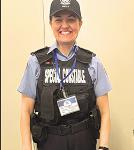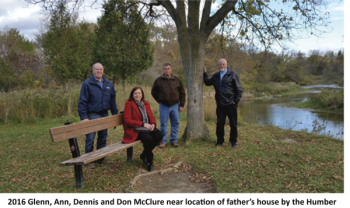
Bow Bent Farm revisited
BY TIM LAMBRINOS
Issac Devins, a Pennsylvania German, was the first settler to arrive at Emery in 1795. For his farm, he selected a 200 acre lot at two newly cleared dirt roads situated on the southwest corner of the intersection of Finch and Weston Road. His lot extended west for a mile and a quarter to Islington Avenue by the Humber River. Devins and his wife Mary Chapman first decided to build a log cabin in this picturesque location along the banks of the Humber River southeast of Islington and Finch. 
Over the next 100 years, key pioneers in this specific area were often part of the historic Rowntree clan. James Rowntree, the son of Joseph Rowntree, was born April 1, 1852. On June 3, 1881, he married Caroline Crosson of a nearby farm (Bluehaven area). When their daughter Edith was married on Oct. 19, 1921, Caroline convinced her father to sell his farm to his new son-in-law, Fullerton McClure of Woodbridge.
Enter the McClure family to our community. By the 1920’s, their farm near Islington Avenue had developed into a very prosperous dairy farm operation run entirely by Fullerton and Edith. Their operation was mainly Holstein cows. They also grew some crops and had a chicken coop. The boundary lines of the farm were Finch Avenue to the north with the Humber River to the south. They named their farm, The Bow Bent Farm. They established the farm’s name as a result of the incredibly winding sections of the Humber River at their southern boundary line. Their farm sign’s lettering was made entirely out of bottlecaps.
The McClure’s had one son Bruce that was brought up mainly to help with the chores. He was born on March 7, 1924 and attended the Emery Public School at Weston Road and Finch for his primary education. He later attended high school at Weston Collegiate in Weston.
As a result of the particularized operations of their dairy farm, Bruce had dreamed of becoming a veterinarian at nearby Guelph College. His best friend, Don Willitts, had also planned to attend college with him. Unfortunately, Bruce was never able to achieve his personal goal. His father Fullerton became too ill to run the farm by himself and Bruce was obligated to give up his career-dream and run the family dairy farm. Don Willitts did attend the college and became a veterinarian on his own.
On September 23, 1950, Bruce married Muriel Elaine Bell. The McClure’s have five children; Don in 1951, Dennis in 1954, Ann in 1955, Glenn in 1960 and Ross in 1966. During the early 1950’s, young Don McClure had one very dangerous mishap that occurred while they were still on the farm. As a toddler, he wandered away by himself behind the chicken coop and the Humber River swallowed him up. He was narrowly saved. 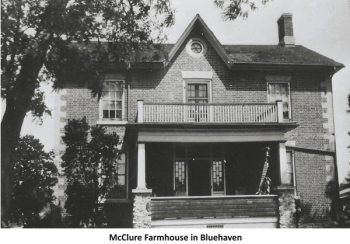
The McClure’s moved to Milton in the summer of 1954. They were extremely fortunate to miss the infamous hurricane that would raise havoc on the surrounding community and totally wipe out many homes and cottages.
In Oct. 1954, Hurricane Hazel ripped full-force through the area as the Humber River flooded six feet over its banks. The heroic efforts of Charlie Jordan (Chief of the Humber Summit Volunteer Fire Brigade) saved all of Emery’s and Humber Summit residents’ lives on that tragic evening. Fortunately, the McClure’s had just relocated to a new farm in Milton only three months prior. The plateau ridge near the Humber where their empty home was standing was hit hard by the hurricane. Raging waters changed the shape of sections of the winding river right where their house had been. The hurricane utterly destroyed the brick farmhouse that Fullerton McClure had built.
In the late 1950’s and early 1960’s, a major deviation in population growth and makeup occurred that coincided with the influx of immigrants to Canada from countries other than the United Kingdom. In Humber Summit, population growth was fuelled by many Italian families that were moving into new residential subdivisions along Finch Ave. The numerous Italian families choosing to move into the new community were obviously influenced by the creation of Camillo Milani’s Italian Gardens Recreation Facility at Islington and Finch.
At Bruce McClure’s former dairy farm, new homes were constructed with select single homes built on Archway, Islay and Bluehaven. The rest of houses in the community followed as semi-detached homes. Mr. Starkman, a jewish businessman, built most of the new homes in the area for the community. By 1967, the young children of these new families were attending a newly built public school, Bluehaven.
At the new Bluehaven Public School, Mr. Eastman was made principal. The librarian, Mrs. Baker, had considerable qualifications. And for the school’s Grade 2 class, a stern disciplinarian was put in place named Mrs. Antrim. She was constantly reprimanding persistent pranks of particular adolescents for placing pointed tacks upright on other students’ chairs. Bluehaven’s new park was massive including a fully improvised par 3 golf course.
The Borough of North York Parks and Recreation Department did their part for the community and erected boards during the winter. This was done so that the community would be able to flood the ground and maintain their own ice rink. Area resident’s garages annually rotated the storing of the large hoses needed to flood the rink. Mr. Tom Cobb of Brubeck Road was an active volunteer for many community sporting events. He took on the role as the main rink flooder. 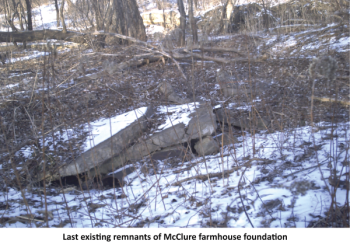
Full hockey games were played on the rink by area boys. One family named Locicero resided on Islay Court. The two boys, named Mike and Frank, both dreamed of becoming NHL goaltenders. They always had brand new equipment. Both boys played on the Bluehaven ice rink and in many street hockey games. The two brothers always played in opposite nets.
Many other area boys from the surrounding streets participated in numerous makeshift hockey games. Andy Oletic, Sam and Fernando Pisano of Bluehaven; Dave Gaston, Leo Cobb, Mike Prete, Frank Jakubowski of Brubeck; Walter Rigobon, Joe Plastina, Clint Leonard of Ardwick; Rob Gabriel, Bill Basso, Gino Prospero, Alexander Kingsley of Peterson; Frank Belyk, Jan Zahn of Islay Court. And Joe Barbutto, Eugene, John and Mario Rubello and Carlo and Bruno Scarpone were all active hockey players at the rink. 
For other recreation, area children were continually exploring the many amazing sections of the Humber River and the old Bow Bent farm. Throughout the ravine, forts were built by children. Some complete with secret passages. Billie Cooper of Bluehaven went door to door in an effort to assess the recreational needs of the community. She was a well-known member of the Forgotten Corners Ratepayers Association. She found the majority of the community wanted a bocce court constructed. The courts were approved and became one of the very first built in North Yorkm, built at Gord and Irene Risk Park.
The childhood home of Frank Belyk on Islay Court was built close to the former McClure farmhouse. As a child, Frank and his friends were constantly finding remnants of the old farmhouse, barn and chicken coop, including animal bones. They even found some unique polished red brick. One time, the boys discovered a skull from a large boar while they had been digging and building a fort by the river.
Since 2005, the Nile Academy has been running a school in the former Bluehaven Public School’s building. They now administer an Ontario Standards Aligned Educational Program that is developed with framework from the Ontario Ministry of Education’s curriculum. Nile Academy is a full school with grades from kindergarten to high school. 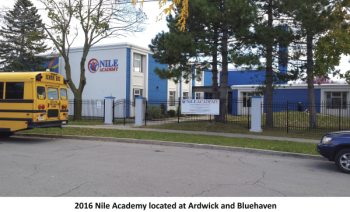
They are a privately-run school with a mission to assist young students in developing interactive skills to manage in today’s rapidly changing society. The school has a reputation in catering for individual needs and diversity. All extra-curricular activities are planned with this goal of enhanced social interaction in mind. The school has been established in our community to meet the needs of a better education and a brighter future for our children.
To cap off the end of a perfect story, Don, Dennis, Ann and Glenn McClure were thrilled to be invited for a tour of their parent’s former farm and inspect the neighbourhood this month. The old McClure farmhouse stood immediately south of modern-day Islay Court behind the backyard of the Belyk’s house. The precise land where Bruce McClure’s farmhouse stood now houses a walking pathway along the banks of the Humber. One idea that might be brought forward is to mount an historic marker close to where the McClure farmhouse stood near this particular part of the Humber River. This would serve to forever recognize the amazing story and history of the McClure family and the Bow Bent Farm.

